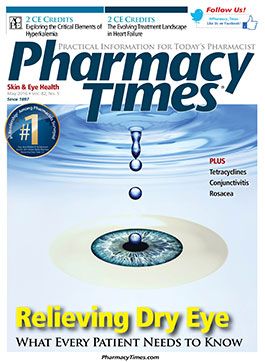Publication
Article
Pharmacy Times
Tetracyclines: Multitasking Fighters of Inflammation
Author(s):
Tetracyclines are go-to, broad-spectrum antibiotics that have been pill-pushed by prescribers nationwide.
Tetracyclines (eg, minocycline, doxycycline, tetracycline)1,2 are go-to, broad-spectrum antibiotics that have been pill-pushed by prescribers nationwide. But who can blame them? Tetracyclines have a vast number of bacteria on their “hit list,” and they have numerous FDA-approved indications for treating infections, ranging from syphilis to anthrax.1
For treating these infections, the general mechanism of tetracyclines is blockage of bacterial protein synthesis. Tetracyclines have been shown to impair bacterial protein synthesis by binding to the 30 S subunit of the ribosome, thereby preventing the ability of transfer ribonucleic acid to bind to the ribosome complex to allow protein synthesis.1,2
In addition to antimicrobial activity, tetracyclines have other indications on their hit list. Current data have shown that tetracyclines can suppress inflammation, angiogenesis, and tumor proliferation.3-5 Their nonantimicrobial properties have made them the preferred agents for treating various noninfectious disease—related disease states—namely inflammation.3-5 However, tetracyclines’ true mechanism of action in treating inflammation is unclear.3-5 Experts4,5 suspect they manage inflammation by:
- Modulating lymphocyte activation and neutrophil chemotaxis (ie, direct neutrophil migration to bacterial infection of inflammation stimuli)6
- Inhibiting matrix metalloproteinases (ie, proteins that hydrolyze components that create optimal environments that aid in development and morphogenesis)7
- Inhibiting phospholipase A2 (ie, precursor for inflammatory mediators)8
- Inhibiting nitric oxide synthesis • Inhibiting caspase 1 (ie, protein that activates inflammatory mediators)9
Due to these purported mechanisms, tetracyclines have made a lasting impact on the management of various inflammatory- related disease states.
Acne
The 2007 American Academy of Dermatology guidelines recommend minocycline or doxycycline as the preferred first-line oral agents for managing moderate to severe acne. This recommendation is based on over 20 randomized control trials suggesting that these agents were consistently effective for treating acne in affected patients. In addition, trimethoprim/sulfamethoxazole or erythromycin can be used as alternatives for patients who cannot tolerate such tetracyclines.10
Rosacea
The 2014 American Acne & Rosacea Society guidelines recommend lowdose doxycycline, at 40 mg once daily, for patients with rosacea—specifically patients with centrofacial erythema with papulopustular lesions. This dosage is recommended for patients who may not be adherent to topical administrations. Other tetracyclines or macrolides (eg, azithromycin) may be used as alternatives based on the clinician’s judgement. This recommendation is based on expert opinion.11
Rheumatoid Arthritis
The 2012 American College of Rheumatology guidelines recommend minocycline for the treatment of rheumatoid arthritis (RA). Minocycline should be used in patients with early RA in the presence of low disease activity or in patients with moderately or highly active disease without poor prognostic factors. Minocycline can be used in both patient groups as long as they have had RA for fewer than 6 months. This recommendation is based on multiple randomized clinical studies.12
Periodontitis
The 2015 American Dental Association guidelines for periodontitis recommend doxycycline as the preferred agent for patients with severe chronic periodontitis. Specifically, the anti-inflammatory formulation dose (40 mg once daily) is recommended. This is based on 11 randomized control trials suggesting that doxycycline is safe and effective for treating periodontitis after 3 to 9 months of daily treatment.13
Mohamed Jalloh, PharmD, is an instructor at Creighton University in Omaha, Nebraska, and a community pharmacist at Walgreens.
References
- Online database. Clinical Pharmacology website. clinicalpharmacology-ip.com/default.aspx. Accessed March 29, 2016.
- Hash JH, Wishnick M, Miller PA. On the mode of action of the tetracycline antibiotics in Staphylococcus aureus. J Biol Chem. 1964;239:2070-2078.
- Sapadin AN, Fleischmajer R. Tetracyclines: nonantibiotic properties and their clinical implications. J Am Acad Dermatol. 2006;54(2):258-265.
- Ishikawa C, Tsuda T, Konishi H, Nakagawa N, Yamanishi K. Tetracyclines modulate protease-activated receptor 2-mediated proinflammatory reactions in epidermal keratinocytes. Antimicrob Agents Chemother. 2009;53(5):1760-1765. doi: 10.1128/AAC.01540-08.
- Griffin MO, Fricovsky E, Ceballos G, Villarreal F. Tetracyclines: a pleitropic family of compounds with promising therapeutic properties. review of the literature. Am J Physiol Cell Physiol. 2010;299(3):C539-C548. doi: 10.1152/ajpcell.00047.2010.
- Nuzzi PA, Lokuta MA, Huttenlocher A. Analysis of neutrophil chemotaxis. Methods Mol Biol. 2007;370:23-36.
- Sorsa T1, Tjäderhane L, Salo T. Matrix metalloproteinases (MMPs) in oral diseases. Oral Dis. 2004;10(6):311-318.
- Meyer MC, Rastogi P, Beckett CS, McHowat J. Phospholipase A2 inhibitors as potential anti-inflammatory agents. Curr Pharm Des. 2005;11(10):1301-1312.
- Keller M, Rüegg A, Werner S, Beer HD. Active caspase-1 is a regulator of unconventional protein secretion. Cell. 2008;132(5):818-831. doi: 10.1016/j.cell.2007.12.040.
- Strauss JS, Krowchuk DP, Leyden JJ, et al; American Academy of Dermatology/American Academy of Dermatology Association. Guidelines of care for acne vulgaris management. J Am Acad Dermatol. 2007;56(4):651-663.
- Del Rosso JQ, Thiboutot D, Gallo R, et al; American Acne & Rosacea Society. Consensus recommendations from the American Acne & Rosacea Society on the management of rosacea, part 5: a guide on the management of rosacea. Cutis. 2014;93(3):134-138.
- Singh JA, Furst DE, Bharat A, et al. 2012 update of the 2008 American College of Rheumatology recommendations for the use of disease-modifying antirheumatic drugs and biologic agents in the treatment of rheumatoid arthritis. Arthritis Care Res (Hoboken). 2012;64(5):625-639. doi: 10.1002/acr.21641.
- Smiley CJ, Tracy SL, Abt E, et al. Evidence-based clinical practice guideline on the nonsurgical treatment of chronic periodontitis by means of scaling and root planing with or without adjuncts. J Am Dent Assoc. 2015;146(7):525-535. doi: 10.1016/j.adaj.2015.01.026.







